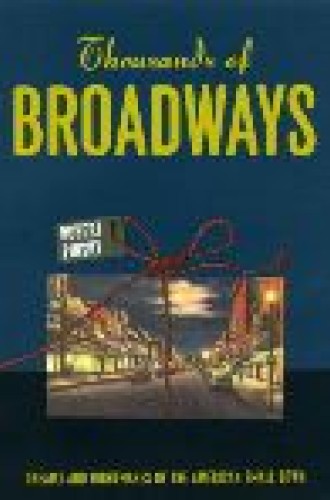Thousands of Broadways/Lights on a Ground of Darkness
Two of America’s recent poets laureate have published small books on American hometowns—one focusing on the hometown in literature and film, the other a series of recollections from the poet’s childhood. Both poets are honoring their parents, and both show us the evening glow of nostalgia in opposition to the instinct to move forward without stopping to reminisce. Readers who have villages in their lives or see village dynamics in their congregations might enjoy these brief guides through the comfort and meanness of small communities.
Sunday morning lectionary readings certify our citizenship in Jerusalem, Rome, Corinth, and other cities where cultures clash and ideas compete. The worlds of scripture plant us with Mary and Joseph, Martha and Mary one day, and the next day let us grow to mature action, following Paul into adventuresome evangelism and new designs. In reflection and holiday homecomings we return to Bethlehem, Nazareth, Bethany, and the other villages where our tribe once gathered, to childhood churches and neighborhoods. Our big ideas and big ambitions run to the city the way rivers run to the sea, but faith and values are born in places small enough to create comfort zones around young lives, quiet enough for spiritual exercises and safe enough to support and encourage singing.
Read our latest issue or browse back issues.
Robert Pinsky’s Thousands of Broadways analyzes the American town of the 19th through the middle of the 20th century “as it lives in a few specific, impressive works of art." His own hometown—Long Branch, New Jersey—turns up throughout the book, folded into the chapters as the memories of it might be folded into Pinsky’s everyday thoughts. Ted Kooser’s Lights on a Ground of Darkness is the poet’s gift to his mother. As she lay dying in an assisted-living apartment, Kooser wrote an essay about her family, a task he had hoped to accomplish since he was a little boy.
The compact and circumscribed isolation of small towns make them islands of human interaction and stages of social drama. Pinsky writes of Long Branch, “I was eleven or twelve years old before I realized that ‘Give My Regards to Broadway’ was not about our street but one of the same name in Manhattan.” Self-contained, self-centered economic and social systems, the Main Streets and Broadways of memory have become “increasingly mythical—with all the underground faults and earthshaking, suspended energies of myth . . . the spectral epitome of the United States itself . . . of a generous American innocence or a nasty, grasping American provincialism.”
When Pinsky came in from the subdued winter streets of his summer-resort town to sing “O Little Town of Bethlehem” with his classmates as a child, he felt the “mysterious power” of the images in that familiar carol. Later in life he could picture the post–Civil War towns “made unnaturally silent by the absence of so many young men,” which songwriter Phillips Brooks might have imagined through the focusing lens of Bethlehem.
Solid academic analysis, not nostalgia, is the foundation of Pinsky’s work on small towns, or so he insists. In a barrage of words near the end of the book, Pinsky unloads on merely sentimental longing: “A response to change so purely regretful that it is generic and cottony, . . . nostalgia is nearly weightless, . . . a blurry retrospective gaze in the wake of loss.” The small town seems to be a breeding ground for such nostalgia.
Pinsky tells of Willa Cather’s “informative and funny” fictional characterizations of public recitations of sentimental poetry around the turn of the 20th century. Mixed with these saccharine and uninspired performances in small towns were the seeds of “genuine art,” and new immigrants and misfits brought a pollinating spirit to encourage its flowering. In Cather’s My Ántonia, resident Thea sings to outsider Spanish Johnny’s accompaniment, and for the first time she feels the response of “really musical people turning themselves and all they had over to her. . . . For the moment they cared about nothing in the world but what she was doing.” The wider world breaks into the small town as new immigrants arrive, while some of the longtime residents struggle to break through the limits of the village for new experiences. Forces of “intimacy and alienation,” innocence and blindness, warm rural acceptance, and “monstrous complacency” collide in the small town. Pinsky writes of the “horror of a small town gaze” and the town’s “readiness to judge and categorize, its narrowness.”
Ted Kooser reads his mother’s small town life as if it were a poem. The stories he tells have the feel of open farmland in their background rhythm. Images of irises recur in his essay just as real irises reappear and thicken in rural gardens such as his grandmother kept. Kooser’s people do not covet the suburbs or aim their ambitions toward major cities. They live in the country, fish in the river and play cards in the evening. They work at common jobs, keep modest homes, find happiness in neighborly recreation, enjoy community in or near their workplaces, and make music together on the weekends. His mother’s family was known “for the way they thoroughly enjoyed their lives. When they sang together after dinner, their voices filled the valleys.”
As a poet, Kooser found his vocational models in those ordinary places and quiet activities. Looking back at the retired farmers who sat in the shade outside his grandpa’s filling station swapping stories, he realized that the poems and stories he learned to write were his way of “applying for acceptance into this same circle of old men.”
Nostalgia to Kooser is an old cardigan he is not ashamed to wear. He writes that in middle age he was “nostalgic for his grandfather’s stories,” so he re searched a bit of history about the Turkey River, near which his grand father’s family homesteaded and on which Iowa’s only Revolutionary War naval engagement occurred. Nostalgia—that sweet homesickness for a world dissolved in time—can motivate the student in us. In another scene Kooser writes about visiting the church his great-grandfather helped build in 1850, now unused, having been abandoned by worshipers after about a hundred years of use. The church was one of the few connections he had to his great-grand father, so when the cemetery custodians let Kooser and his mother in, he writes, “I fasten on every detail as if it were a button on his coat.”
A resident of Kooser’s grandparents’ small town was discovered by a music professor at the University of Iowa and was given a scholarship and a start on a performance career that took him around the world. Later in life, crippled with disease, the musician retired to his hometown. At his funeral, neighbors “remarked upon what an odd child he’d been, how much alone and set apart he’d always seemed. He could have been a good farmer, . . . but off he went with his flute, gallivanting all over the world.”
Even as trumpet blasts of big-city bravado fill our daylight hours, when the shadows lengthen, the red wine and oboe sound of nostalgia can be a useful way of loving the world we have been given. Then in the light and vitality of the next working day, art and even knowledge might rise from the bittersweet memories. “Such music there is in the past,” Kooser writes.
People will always need Bethlehems and Long Branches to be born into, to push out of and to return to.







